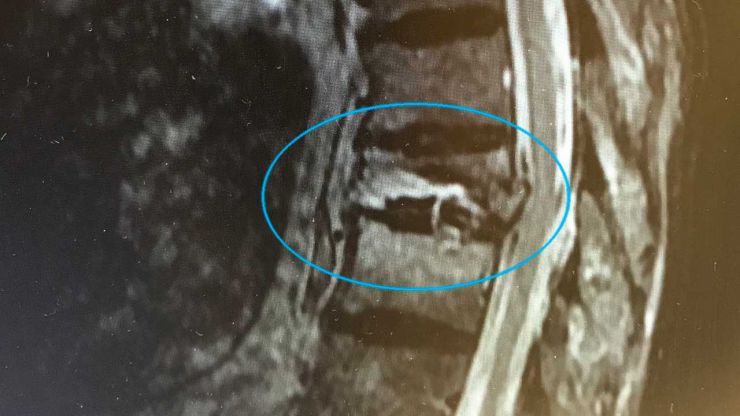Structural Injuries
DISORDERS AFFECTING BONY STRUCTURES
Spinal Fractures are different from a broken arm or leg because these injuries may involve the spinal cord. Since the spinal column acts as the spinal cord's suit of armor, any damage to the column could place the spinal cord and its 31 pairs of nerve roots in danger.
Not only is a vertebral body vulnerable to break age, but so are its attachments such as the facet joints, pars articularis, and spinous process. Damage to any of these bony components could jeopardize the integrity of the spinal cord and its nerve structures.

Compression Fractures of the spine are one of the more common injuries sustained by a vertebral structure. The vertebral body itself is the largest single unit of a vertebra. Its structural integrity is similar to a cardboard box.
Imagine a cardboard box; big and sturdy in appearance, but hollow on the inside. Now, let's say a great deal of pressure is placed on this box (vertebral body).
Perhaps a hyperflexion injury (hi-per-flex-shun) occurs. In this case, hyperflexion means the neck or low back is forced to bend too far forward or sideways. The result? A crushing effect causes the box (vertebral body) to resemble a wedge
The amount of force delivered to each vertebra is shared directly with the surrounding spinal elements. It might be assumed the smaller cervical vertebrae would be more susceptible to injury simply based on size. Injury of this type generally does not occur often in the lumbar region, due to the size and density of the lumbar vertebrae.
Other fractures can occur from forces that cause the body to torque (twist). Even a direct blow to the spine can cause a fracture. Other parts of the vertebra such as the facet joints, or other bony processes, can break possibly causing dislocation of a vertebra and, perhaps, paralysis to some body part.
Although bone is a hard material, it can crack, split, or break away from the parent bone. Spinal fractures require immediate medical attention. An unstable fracture may be a serious condition causing one or more bone fragments to press against the spinal cord or nerves.
In osteoporosis (os-tea-oh-pour-oh-sis), a bone density disease, the effected bones weaken, become porous, and may become as delicate as fine porcelain. These bones are especially susceptible to breakage.
The type of fracture is determined by an x-ray. The treatment depends on the type of fracture and its location. Some fractures will require surgical intervention while others only need to be stabilized with bracing. One of the first steps is to stop movement to con trol and/or minimize damage.
When a vertebra breaks, the body's first response is to begin the healing process. Initially, a granular material termed a callus is formed at the fracture site. In addition, collagen, a protein is transported to the fracture site through the blood stream. Collagen assists in the mending or knitting process. After the new bone is sealed together with the old, it is hardened through a process termed calcification.
Years ago a patient with a broken back may have had to wear a plaster body cast. Fortunately, this is not the case today. Plastics have revolutionized the cast business. Most plastic casts are custom-fitted removable braces designed to be comfortable. Today, most spinal fractures may be more of an inconvenience than a tragedy.
SpondyloIisthesis (spon-dill-oh-liss-thee-sis) is a fancy long term meaning one vertebra slips over another. Although this disease primarily effects the elderly as a degenerative disease, it may be congenital (present at birth) or discovered early in life.
Childhood spondylolisthesis can be caused when the pars articularis (par-z-are-tick-you-layer-es) does not fuse during early development. When these bony pieces do not grow together, a bony posterior weakness results in the vertebra
Spondylolisthesis may result after injury or dur ing overuse because the existing bony weakness lends the area susceptible to breakage. A physician whose speciality is the spine best deals with this condition.
Elderly spondylolisthesis may result when the stabilizing spinal structures begin to deteriorate. This occurs particularly in the lower back, which is responsible for carrying most of the body's weight.
Sometimes the spinal joints become arthritic and wear out, which may create spinal instability. As verte brae lose their normal alignment, one vertebra might actually slip forward over the one below.
When a vertebra slips forward, the neuroforamen (window), where the nerves exit the spinal canal, may become closed causing nerve compression and sciatica. This condition is similar to spinal stenosis.
Pain and other symptoms may be alleviated with a surgical procedure termed a foraminotomy (four-aye men-ott-toe-me). This procedure surgically increases the size of the neuroforamen and cleans away any de bris that may clog the window.
In most cases, spondylolisthesis can be treated nonsurgically with a course of physical therapy supple mented with steroid-anesthetic injections, prescriptions, and/or over-the-counter oral medications for inflamma tion and pain.
In a few instances conservative measures fail. Depending on the patient's symptoms, a surgical pro cedure termed a laminectomy (lamb-in-eck-toe-me, removal of bone) combined with spinal fusion may be necessary. Spinal fusion stabilizes the affected area(s) of the spine using hardware (rods, screws, plates) and bone grafting.
